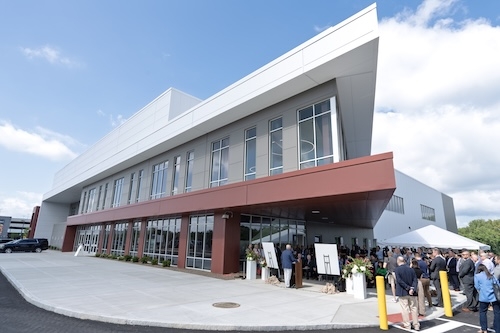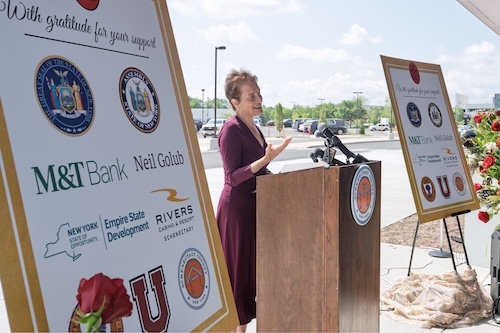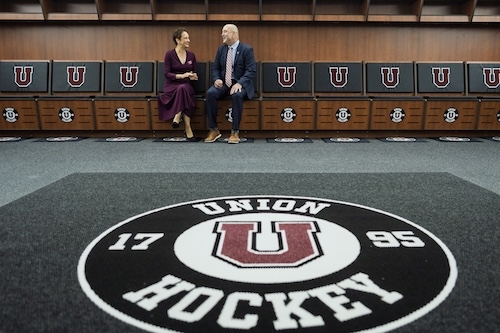College Sports
Kansas State University
CARLSBAD, Calif. – Kansas State senior Carla Bernat and sophomore Alenka Navarro ended their season on a high note on Monday as each went under par and finished in a tie for 14th during the final round of stroke play at the 2025 NCAA Championship on Monday at the par-72, 6,330-yard Omni La Costa Resort […]

Bernat and Navarro tied for 14th place at 2-under par 286. Bernat turned in a final-round score of 5-under par 67, while Navarro finished her final round of the season at 4-under par 68.
Beginning on the back 9, Bernat began her final collegiate round with birdies on each of her first three holes. After a bogey on the par-4 15th, Bernat finished her first nine holes with a birdie on No. 18.
Bernat proceeded to finish the final nine holes of her collegiate career bogey free and 2-under par, closing out one the most illustrious seasons and careers in program history.
“Her play was incredible,” head coach Stew Burke said. “The golf course is so difficult, especially in the afternoon when the greens are firm and the wind is whipping. She’s going to do this for a living and for a very long time in the future. Rounds like today to finish off her career at the standard that she set all year is just Carla being Carla.”
Bernat finished her career ranking first in school history in both career (70.44) and single-season (70.08) scoring. She also finished in program history second in career wins (5), top-five (14) and top-10 (16) finishes.
“We had a vision,” Burke said. “Gene Taylor believed in our vision, then Rinko Mitsunaga believed in my vision for the program. Carla was the first piece of the puzzle. She’s been incredible as a leader on the golf course, what she does in the weight room and just how she carries herself and how she represents us. I am really, really proud of her.”
Navarro also started off her round with a bang as she holed out for eagle from 97 yards on the par-5 10th, while the sophomore also birdied No. 14. Following bogeys to finish out her first nine holes on Nos. 15 and 18, she began the front 9 with birdies on Nos. 1, 2 and 5 as part of her bogey-free front 9.
A native of Mexico City, Navarro finished her second collegiate season ranked sixth in school history with a 73.58 scoring average. She enters her junior campaign ranked second in school history with a 73.68 career scoring average.
“It was a really incredible round,” Burke said. “She started out of the gate hot. She made a couple of mistakes and was a little wobbly in the middle, then she just kept the pedal down. I am really proud of her. She hit some shots that were truly world class today.”
Arkansas’ Maria Jose Marin was crowned the 2025 NCAA Individual Champion after firing a 12-under par 276. She led Arkansas to the No. 6 seed in match play, which begins on Tuesday. Stanford is the top seed after finishing stroke play at 27-under par 1,125. The other six teams that moved on to match play are Oregon, Northwestern, Florida State, USC, Texas and Virginia.
College Sports
New arena for men’s and women’s hockey programs officially unveiled
Just over a year ago, ground was broken on an all-purpose arena that would serve as the new home of the Division I men’s and women’s hockey programs. The M&T Bank Center at Mohawk Harbor, the new home of the Division I men’s and women’s hockey programs, was officially unveiled during a ribbon-cutting ceremony Thursday […]

Just over a year ago, ground was broken on an all-purpose arena that would serve as the new home of the Division I men’s and women’s hockey programs.
A mere 13 months later, the M&T Bank Center at Mohawk Harbor was officially unveiled during a ribbon-cutting ceremony and tours Thursday morning.
A gathering of state, county and local officials and dignitaries, including New York Gov. Kathy Hochul and Union President Elizabeth Kiss, celebrated the milestone.
“President Kiss, this is a big day for you and the extraordinary men’s and women’s hockey teams,” said Hochul. “Hopefully we will be sending off Olympians and professionals from this very location.”
Kiss took over as president July 1. She credited her predecessor, David Harris, for his key role in making the new arena a reality.
“This gorgeous event center is really a game changer for Union College,” said Kiss. “This is going to take us to a whole new level in attracting even more top-notch student-athletes, as well as fans and coaches. The arena will add to the renaissance and vibrancy of Schenectady, and help bring the community together.”
The $55 million project features a 2,200-seat ice hockey rink with capacity expanding to 3,600 for other sporting events, trade shows, special events and conventions.
The nearly 100,000-square-foot arena will be located steps from College Park Hall, providing easy access from campus. It is also near two hotels, restaurants and other retail establishments, making it more inviting for fans and visiting teams.
Among the highlights:
- Seven luxury suites and a large capacity hospitality suite
- Two full-service concession stands featuring a menu by Victory Concessions, which is owned by the Mallozi family, which also operates Johnny’s Restaurant and Villa Italia in downtown Schenectady
- An elegant bar overlooking the Mohawk River
- Parking on-site and ancillary 700-space lot within walking distance
The women’s hockey will debut at the center on September 26 against Franklin Pierce, while the men’s team will play their first game on October 4 against Army/West Point. Tickets are available at unionathletics.com.
The first public event will feature a performance by country singer Lee Brice on September 6, with special guest David J.
Plans for the new venue were first announced in spring 2022.
The College has negotiated a long-term lease with the developer, Maxon Alco Holdings, LLC, an affiliated company of the Galesi Group, to be the primary tenant for the arena. The College will contribute $20 million over 25 years to host the hockey programs.
The new arena is a major upgrade for the College’s hockey teams, which had played their games in the 2,051-seat Frank L. Messa Rink at Achilles Center. From the time it hosted its first game Dec. 5, 1975, against the University of Ottawa, the classic hockey barn has provided one of the greatest atmospheres in college hockey.
But after decades of use, Messa Rink was in need of significant upgrades to remain competitive with other Division I facilities in ECAC hockey, to enhance the fan experience and address its mechanical infrastructure.
The College weighed a number of options, including building a new rink of its own or repairing and renovating Messa. College officials ultimately decided the best option was to enter into a public-private partnership to lease space at the new arena, in part because expenses are shared with other parties.
To support the project, State Assemblyman Angelo Santabarbara helped secure $10 million from the state; the Schenectady County Legislature contributed $5 million, the Schenectady City Council $2.5 million and trustee Neil Golub $1 million.
Both hockey programs began moving into their new space this week. The facility will provide upgraded, private locker rooms for both teams as well as dedicated strength and conditioning and athletic training spaces.
The rink comes at a time when the NCAA recently allowed both Union hockey teams to offer athletic scholarships for the first time. The shifting dynamics in college sports, particularly with the transfer portal, has upended the competitive landscape. Without the ability to offer scholarships, both hockey teams were at a distinct recruiting disadvantage.
Now, scholarships and a new rink will greatly enhance the College’s ability to compete at the highest level in men’s and women’s hockey to attract exceptional student-athletes.
Also, shifting the hockey programs from Messa will free up valuable space in the Achilles Center for other athletic uses. Messa is being converted into an indoor turf facility.
The M&T Bank Center is part of Schenectady’s ongoing revitalization efforts, joining the $650 million Mohawk Harbor development that includes an amphitheater, apartments, hotels and more.
“One of the reasons my husband, Jeff, and I got so excited about this opportunity to join Union College and be a part of this Schenectady community is because of the amazing energy around town and gown,” Kiss said. “And the willingness to punch above our weight.”
College Sports
Nedoroscik begins push for LA ‘28 • USA Gymnastics
As double Olympic bronze medalist and four-time U.S. champion, Stephen Nedoroscik prepared to return to competition at the 2025 Xfinity U.S. Gymnastics Championships in New Orleans, Louisiana, he reflected on a storybook ending to 2024 and a relatively late start to his return to competition in 2025. By Sarah Firth/USAG Creator Program As double Olympic […]

As double Olympic bronze medalist and four-time U.S. champion, Stephen Nedoroscik prepared to return to competition at the 2025 Xfinity U.S. Gymnastics Championships in New Orleans, Louisiana, he reflected on a storybook ending to 2024 and a relatively late start to his return to competition in 2025.
By Sarah Firth/USAG Creator Program
As double Olympic bronze medalist and four-time U.S. champion, Stephen Nedoroscik prepared to return to competition at the 2025 Xfinity U.S. Gymnastics Championships in New Orleans, Louisiana, he reflected on a storybook ending to 2024 and a relatively late start to his return to competition in 2025. Through it all, he has his eyes set on the horizon of the 2028 Olympic Games in Los Angeles.
Clinching the team bronze and then doubling back to win pommel horse bronze in Paris was just the start of Nedoroscik’s rocket boost into the world of mainstream celebrity. He returned from Paris to become the first male gymnast to compete on Dancing with the Stars, appearing in Season 33 with partner Rylee Arnold and making it to the season finale, where the duo placed fourth. He also co-hosted the Dancing with the Stars nationwide tour, which kept him off the pommel horse until the spring. In April, he resumed training at EVO Gymnastics in Sarasota, Florida.
“I’ve always told myself, ‘I want to be done with the sport when my body is done with the sport,’ and I’m still getting better,” said Nedoroscik. “I feel like I’d be doing myself a dishonor to not see how far I could go.”
At the Championships in New Orleans, he dipped his toes back into competition with nothing but positive support from his fans. “Being able to hear people cheer and root me on … this is what you do this for,” Nedoroscik said after the first day of competition. “Seeing these (kids) look up to me, doing a horse routine for them and hearing them cheer. It’s seriously amazing seeing how the community is backing not only me but the rest of the guys here. I’m more than happy to take pictures and sign (autographs) with them.”
After placing fifth in New Orleans, Nedoroscik now returns to the gym to double down on getting back to the gymnastics that has been the center of his daily life and goal-setting, with his focus firmly on three years in the future.
“I’m going to continue going,” he said. “L.A. [2028 Olympics] would be amazing, so I want to shoot for that.”
Until he hit the cultural big-time, the single-event specialist had to make ends meet through a combination of support from USA Gymnastics’ athlete tier funding, the USA Gymnastics Foundation, and his club, EVO Gymnastics. Unlike many gymnasts, Nedoroscik didn’t have a full scholarship while competing in college and graduated with a significant amount of student loan debt. Earning a salary to train and compete after college is what kept him in gymnastics—and ultimately made it possible for him to still be in the sport when the 2024 Olympics came around.

The Massachusetts native moved from Penn State to Florida to train with EVO, but living and training in Florida as a post-collegian does come with its challenges for Nedoroscik, even with his finances now on more solid footing. Due to vision issues with depth perception and bright headlights, Nedoroscik does not currently hold a driver’s license and is unsure whether he will be eligible to obtain one in the future. Nedoroscik lives a 30-minute drive from the gym and figuring out daily transportation to and from training is still an ongoing challenge with the lack of public transport options in the city.
“As of recently I’ve been Uber-ing [each day], which is not the best long-term solution,” he laughed.
Outside of the gym, Nedoroscik is internationally known for his Rubik’s Cube prowess and is also a keen chess player – most recently competing in a celebrity chess competition hosted by chess.com called PogChamps 6 in late April to early May. Nedoroscik made it to the semifinals of the championship bracket, winning an $8,000 cash prize, before being eliminated by Premier League athlete Ebere Eze, the competition’s eventual champion. His lifetime highest rating on chess.com peaked near 1300 and currently stands at approximately 1150 .
“At times, I had really cool moves that really impressed the judge or the actual chess grandmasters that were commentating [the competition], which I was really proud of,” said Nedoroscik .
Back in the gym, he spoke about an unusual strategy he uses to maintain his strength while training: a bowl of mint chocolate chip ice cream before bed every night.
“I’ve always been a snacker throughout my life, and it’s how I grew up. But, when I got to college, a lot of people were like, ‘Hey, dude, you should like, eat healthier’… So, I ate healthier and lost like 15 pounds,” said Nedoroscik. “I quickly realized maybe having some sort of a calorie boost throughout my day is a good thing, and for me over the years, I just found that a nice bowl of ice cream at night is enough to keep me maintaining my weight.”
It seems the simple solution worked. In addition to his Olympic success, Nedoroscik was named the USA Gymnastics Athlete of the Year at the 2025 Xfinity U.S. Gymnastics Championships. With yet another competition under his belt, Nedoroscik stays focused on 2028.
College Sports
Sweebe Family Indoor Athletic Center
The Sweebe Family Indoor Athletic Center opened in August of 2025. The centerpiece of the facility is a 131,000-square-foot air-supported dome that includes a full-size turf field and a four-lane track. Standing 90 feet tall, the Dome is a striking new landmark visible from across campus. Attached to the Dome is a 5,000-square-foot lobby featuring […]

The Sweebe Family Indoor Athletic Center opened in August of 2025.
The centerpiece of the facility is a 131,000-square-foot air-supported dome that includes a full-size turf field and a four-lane track. Standing 90 feet tall, the Dome is a striking new landmark visible from across campus.
Attached to the Dome is a 5,000-square-foot lobby featuring two changing rooms, an athletic training room, and an office space to support team operations.
The $11 facility is designed to serve multiple sports, including football, soccer, rugby, track & field, baseball, softball, and lacrosse. It’s fully equipped with a portable sound system, scoreboards, and shot/play clocks making it suitable for hosting indoor competitions during inclement weather.
The Sweebe Family Indoor Athletic Center is located on the site formerly known as the “Back-40,” nestled between Nicolay Field and the Adrian College Track & Field Complex. In addition to enhancing year-round training opportunities, the project also expands parking options for surrounding athletic venues.



College Sports
What Everyday Medicine Can Learn From Elite Sports Doctors
On a typical Saturday afternoon in Newcastle upon Tyne, England, Paul Catterson, MBBS, takes his place beside the pitch at St. James’ Park, home turf to the Newcastle United football squad. The chants of 50,000 fans echo through the stands, the tension of Premier League football — with a new season kicking off this week […]

On a typical Saturday afternoon in Newcastle upon Tyne, England, Paul Catterson, MBBS, takes his place beside the pitch at St. James’ Park, home turf to the Newcastle United football squad. The chants of 50,000 fans echo through the stands, the tension of Premier League football — with a new season kicking off this week — thick in the air. But Catterson, the club’s doctor, is immune to the spectacle. His focus is absolute. He watches every collision, every awkward landing, knowing any moment he might be sprinting across the grass, making a high-stakes medical decision under the scrutiny of a global audience.

“You’re often working with incomplete information,” Catterson said in a recent interview with Medscape Medical News. “But indecision is a bad decision. You have to make an educated call based on what you see and what you’ve learned from experience.”
Structured Chaos
Elite sports medicine is in many ways a world apart: fast, unpredictable, and often resource-rich, driven by the need to optimize performance and minimize downtime. Yet as medicine continues to evolve, the lessons from this high-pressure environment are proving increasingly relevant to physicians in general practice. Rapid clinical assessments, effective risk stratification, calm leadership, and evidence-based innovation are not exclusive to stadiums. They are essential tools in any clinic, urgent care center, or emergency department.
“I approach injuries the same way on the field as I do in the clinic,” said Bruce Miller, MD, MS, an orthopedic sports medicine surgeon at the University of Michigan in Ann Arbor, Michigan, who treats college athletes playing American football, ice hockey, rugby, and other sports. “The key difference is time and resources. On the field, we make decisions instantly, without imaging or labs. It forces you to hone your instincts, and that’s something any doctor can benefit from.”
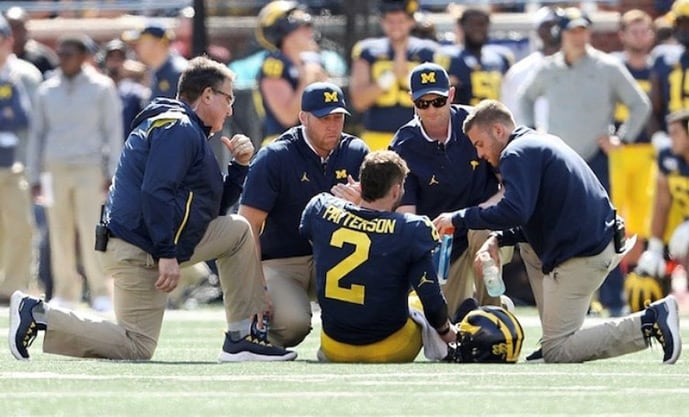
The most striking difference between pitch-side and clinical medicine is immediacy. “What you don’t have on the pitch is history,” Catterson said. “You don’t know what’s happened after the injury, whether it’s swollen or locked. You have to rely on what you saw, what the athlete tells you, and one or two exam techniques that you trust implicitly.”
Catterson, who was previously a consultant in a Newcastle emergency department, said experience and pattern recognition are critically important for success in his pitch-side role.
“One of my old mentors said it best: Always make a decision. Even if it’s not perfect, it’s better than hesitating. I’ve been caught out before, thinking a knee was fine when it was actually a torn [anterior cruciate ligament] ACL,” he said. “You develop a healthy suspicion” for events or movements likely to cause serious injury.
Video replay helps, too. English Premier League teams now use dedicated medical video operators during games. “I can watch the mechanism of injury back within seconds,” Catterson said. “Was it valgus? Was there rotation? It helps me direct the physio during their on-field assessment.”
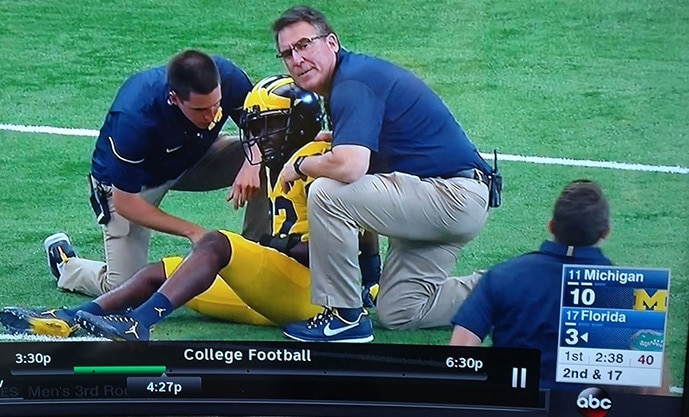
Miller said he leans heavily on the “time-zero” exam. “The best information you’ll ever get is within 60 seconds of the injury. Before the joint stiffens, before pain escalates. That physical exam, when you’re fresh off the injury, is gold.”
Immediacy demands confidence. “There’s no room for dithering,” said Rob Broomhead, MD, a consultant anesthetist who covers NFL games and major boxing events in the UK. “We’ve had players with open fractures, collapsed lungs, cardiac arrests. You’re exposed, with 60,000 people watching, and in the NFL’s case, 20 American doctors and a legal team analyzing your every move. You have to know what you’re doing. There’s no luxury of second-guessing.”
Moving Beyond RICE
The traditional tools of immediate injury care — rest, ice, compression, elevation — are being re-evaluated in elite settings. “RICE was a good starting point, but evidence has moved on,” Catterson said. “We’re now looking at optimizing tissue healing, not just reducing symptoms.”
For instance, the medical staff at Newcastle United use biomarker analysis extensively. “We look at high-sensitivity C-reactive protein, inflammatory cytokines, muscle enzymes,” Catterson said. “We match those to GPS data, distance covered, and sprint load. That helps us detect overtraining early or identify if a player is struggling to recover.”
And ultrasound, once confined to hospital radiology departments, is now a pitch-side essential. “It’s my stethoscope,” he said. “I’ll take the history, do the exam, then scan the joint on my iPad with a wireless probe. It’s changed the way I practice.”
Miller, however, is less likely to call for imaging so quickly. “We’re relying less on fancy diagnostics and more on fundamental skills,” he said. “We’ve realized how much can be missed if you jump to imaging too fast without a thorough physical examination. A good exam is irreplaceable.”
Bright Lights, Big Stages
But pitch-side care is not only about practicing medicine; the ability to manage chaos is a critical skill. “While our focus is singularly on the injured athlete, there are many potential distractions,” Miller said. “It’s the noise, the crowd, and the cameras. You have to block that all out and focus on the athlete. That takes discipline and experience.”
Michigan Stadium, home of the Wolverines, is known as “The Big House” for a reason: the arena can hold over 115,000 fans — the most in the Western Hemisphere and the third largest in the world. “Everything is televised, and there’s zero margin for error,” Miller said. “But the standard of care has to be the same whether I’m in the stadium, in my clinic, or at a rural rugby ground. That’s the expectation.”
Catterson agreed. “You learn to stay calm under pressure. Emergency medicine taught me that, and I brought it into football. We drill scenarios constantly — cardiac arrest, spinal injuries, airway compromise. Everyone has a role. It’s like a Formula One pit crew.”
Broomhead, who manages critical trauma cases on the roadside and in elite sports, said a team dynamic is crucial. “The best sports coverage now mirrors trauma care,” he said. “Clear leadership, well-rehearsed roles, and constant training. Tottenham Hotspur, for example, has what’s basically a mini emergency department under the stadium” in London, England, where the Premier League team plays.
From the Stadium to the Surgery
So what, precisely, can everyday clinicians take from this world?
First, decisive action. “In general practice, you’re often unsure,” Catterson said. “But that’s no excuse for paralysis. Make a plan. Use your tools. One test that you trust for each joint. Anterior drawer for the knee, external rotation for the shoulder, whatever works, have it ready.”
Second, structured frameworks. The Football Association’s mandatory pitch-side training ATMMiF — short for Advanced Trauma Medical Management in Football — borrows heavily from emergency medicine and Advanced Trauma Life Support. “ABCDE, secondary survey, spinal precautions,” Catterson said. “These are things any clinician can adapt to their setting such as urgent care, clinics, sports days at schools.”
Third, the value of preparation. “We rehearse emergencies relentlessly,” Broomhead said. “Even in primary care, there’s no reason not to run drills, collapse in the waiting room, anaphylaxis, sudden breathlessness. You’re only as good as your last rehearsal.”
Fourth, embrace technology. “Musculoskeletal ultrasound, wearable sensors, portable diagnostics — they’re no longer expensive luxuries,” Catterson said. “If you can learn to use them, they’ll change how you practice.”
And finally, embrace the patient as a person, not just a case. “In elite sport, we know our athletes inside out,” Miller said. “Their personalities, their pain thresholds, and how they react to setbacks. That relationship makes all the difference in providing care under pressure.”
A Converging Frontier
Elite sports medicine has always been on the edge: rapid, reactive, and relentless. But in its evolution lies something transferable: a distillation of clinical decision-making under pressure, grounded in experience, and guided by structure.
In a healthcare system strained by time, complexity, and demand, the lessons from the sideline may be just what the clinic needs.
“I really don’t see two worlds anymore, just one continuum of care,” Miller said. “Whether you’re treating a Premier League striker or a construction worker with a torn meniscus, you’re trying to help them recover and return to what they love doing.”
College Sports
Men’s Hockey Announces 2025-26 Newcomers
Story Links TROY, N.Y. – The Rensselaer Polytechnic Institute (RPI) men’s hockey program and C. Lloyd Bauer ’55 Endowed Head Coach Eric Lang have announced the addition of 19 newcomers ahead of the Engineers’ 2025-26 campaign. This year’s incoming class is comprised of ten freshmen and nine transfers, including two graduate students. […]

TROY, N.Y. – The Rensselaer Polytechnic Institute (RPI) men’s hockey program and C. Lloyd Bauer ’55 Endowed Head Coach Eric Lang have announced the addition of 19 newcomers ahead of the Engineers’ 2025-26 campaign. This year’s incoming class is comprised of ten freshmen and nine transfers, including two graduate students. The group features 10 forwards, seven defensemen, and two goaltenders, bringing a diverse blend of NCAA experience and junior success from leagues such as the USHL, BCHL, AJHL, NAHL, and OHL—as well as international competition from Europe’s top junior circuits.
“We are incredibly excited about this recruiting class,” said Coach Lang. “We’ve identified hard skill and high character players from winning programs who will not only set the standard for how RPI hockey needs to play today but while also lay the foundation for our future. We have players that have an opportunity to play and be a part of a special RPI hockey fraternity. We can’t wait to coach and develop this special group.”
Presenting the 2025-26 RPI Men’s Hockey newcomers, in alphabetical order:
Ethan Bono – Junior (Transfer – Merrimack College)
Center – 6’3″ – Port McNeill, British Columbia
Bono arrives in Troy after a two-year stint at Merrimack College. The 6’3″ centerman appeared in 62 games for the Warriors, recording 18 points in Hockey East play. Prior to college, Bono developed in the BCHL with Alberni Valley, where he posted three straight double-digit goal seasons, including a 17-goal, 20-assist effort in 2022-23.
Bruno Bruveris – Junior (Transfer – Miami University (Ohio))
Goalie – 6’1″ – Riga, Latvia
Bruveris offers a wealth of international and collegiate experience between the pipes. A two-year starter at Miami (Ohio), he made 34 appearances from 2023–25, stopping over 780 shots. Prior to the NCAA, he played three years in the USHL with Cedar Rapids and represented Dinamo Riga in the KHL. Known for his athleticism and composure, Bruveris also played for Latvia’s national junior team.
Matthew Buckley – Freshman
Right Wing – 5’11” – Ottawa, Ontario
Buckley joins RPI after four years in the OHL with the Oshawa Generals, where he amassed 113 points in 237 games. His breakout year came in 2023-24, when he scored 30 goals and added 21 assists.
Cole Gordon – Junior (Transfer – Arizona State University)
Forward – 6’1″ – Windsor, Colorado
Gordon spent two seasons at Arizona State, appearing in 64 games and contributing five points in the NCHC. He previously developed with the NAHL’s Minnesota Wilderness, where he saw significant year-over-year growth, culminating in a 22-point campaign in 2022-23.
Jack Gorton – Junior (Transfer – Boston University)
Right Wing – 6’3″ – Granite Springs, New York
Gorton arrives in Troy from Boston University, where he spent the 2024-25 season. Prior to his time in Hockey East, he enjoyed two productive campaigns in the BCHL with Victoria, posting 45 points (17 goals, 28 assists) in 2022-23.
Landen Hilditch – Freshman
Defenseman – 6’3″ – Surrey, British Columbia
Hilditch brings a physical, shutdown style after spending multiple seasons in the BCHL. He combined for 20 points across 57 games between the West Kelowna Warriors and Penticton Vees in 2024-25. A steady presence on the back end, Hilditch complements RPI’s mix of veteran and rookie defensemen.
Matthew Jovanovic – Freshman
Defenseman – 6’2″ – Toronto, Ontario
Jovanovic returns to the ice after last suiting up with the Des Moines Buccaneers in the USHL.
Thomas Klassek – Freshman
Defenseman – 6’0″ – Klagenfurt, Austria
Klassek brings European experience to the blue line, having played professionally with Klagenfurt AC in Austria. He recorded 17 points in the AlpsHL in 2023-24 and skated in 18 games with the senior team in Austria’s top division during 2024-25.
Nate Krawchuk – Freshman
Goalie – 6’2″ – Thunder Bay, Ontario
Krawchuk joins the Engineers after three seasons with the Sudbury Wolves of the OHL, where he logged 88 total appearances. He registered a 19-20-5 record and made 1,335 saves in 2024-25, including four shootout appearances.
Jackson Kyrkostas – Freshman
Center – 5’11” – West Palm Beach, Florida
Kyrkostas comes to RPI following two standout years with the BCHL’s West Kelowna Warriors. In 2024-25, he led the team in assists (44) and posted 57 points in 54 games after recording 48 points the previous season.
Lucas Lemieux – Freshman
Defenseman – 6’4″ – Edmonton, Alberta
Lemieux is a towering left-shot defenseman who totaled 41 points (13 goals, 28 assists) in 53 games with the Trail Smoke Eaters of the BCHL in 2024-25. He also spent time with Camrose of the AJHL earlier in his junior career. Known for his puck-moving skills and offensive upside from the blue line, Lemieux adds size and scoring punch to the defensive corps.
Alfred Lindberg – Junior (Transfer – American International College)
Center – 5’11” – Hallsberg, Sweden
Lindberg adds experience down the middle after playing the last two seasons at American International College. He recorded 22 points (11 goals, 11 assists) in just 20 games as a junior and added another 11 points in his senior campaign. A product of Sweden’s junior system and the NAHL’s New Mexico Ice Wolves, Lindberg brings a balanced scoring and two-way presence to the Engineers’ forward group.
Trevor Russell – Graduate (Transfer – Michigan Tech)
Defenseman – 6’2″ – Old Hickory, Tennessee
A seasoned NCAA blueliner, Russell played 72 games for Michigan Tech over three seasons. Known for his stay-at-home style, he registered seven assists in 2023-24 and brings CCHA postseason and NCAA Tournament experience to Troy. Russell previously played in the NAHL with Aberdeen, including a breakout 35-point campaign in 2020-21.
Ian Scherzer – Freshman
Center – 5’11” – Villach, Austria
Scherzer played the 2024-25 season in the USHL with the Madison Capitols, where he recorded 20 points in 39 games. Previously, he developed through Rogle BK’s Swedish junior system and brings international exposure to the lineup.
Filip Sitar – Sophomore (Transfer – University of Connecticut)
Center – 5’11” – Ljubljana, Slovenia
Sitar transfers to RPI after one season at UConn, where he skated in 31 games. A former standout in Sweden’s junior ranks, he produced 50 points with Malmö’s U20 team in 2023-24 before joining the Redhawks in the SHL. Sitar also has professional experience in Sweden’s second division.
Kazimier Sobieski – Sophomore (Transfer – UMass Amherst)
Defenseman – 6’0″ – Deerfield, Massachusetts
Sobieski comes to RPI following an impressive 2024-25 season with the USHL’s Youngstown Phantoms, where he totaled 27 points (eight goals, 19 assists) in 38 games. He also spent part of the year with UMass-Amherst, appearing in five games. A puck-moving blueliner with offensive instincts, Sobieski posted 24 points the prior season with Sioux Falls and brings high-end junior and NCAA experience.
Gunnar Van Damme – Junior (Transfer – University of Alaska-Anchorage)
Defenseman – 6’0″ – Pittsford, New York
Van Damme adds depth and physicality to the defensive unit after two seasons at Alaska-Anchorage. He played in 68 games for the Seawolves, notching 16 points, including six this past season. His path to college included stops in the NAHL and OJHL, where he contributed over 50 points and established himself as a dependable two-way presence.
Tyler Wallace – Junior (Transfer – Niagara University)
Forward – 6’2″ – Calgary, Alberta
Wallace joins RPI as a transfer from Niagara University, where he tallied 56 points over two seasons. The Calgary native had back-to-back productive campaigns in Atlantic Hockey, including 13 goals and 17 assists in 2023-24, followed by 14 goals and 12 helpers in 2024-25. Prior to Niagara, Wallace was a prolific scorer in the AJHL, notching 84 points (42 goals, 42 assists) in 2022-23 with the Blackfalds Bulldogs.
Luciano Wilson – Graduate (Transfer – Minnesota State)
Forward – 5’10” – Duncan, British Columbia
Wilson brings over 100 games of collegiate experience from Minnesota State, where he totaled 39 points across three seasons, including 13 points in 2024-25. Prior to his NCAA career, Wilson dominated the BCHL, posting 75 points in 2021-22 with Penticton and 53 with Cowichan Valley in 2019-20.
College Sports
17 W&M Men’s Gymnasts Honored as CGA Academic All-Americans
Story Links WILLIAMSBURG, Va. – The William & Mary men’s gymnastics team continued to build upon the program’s outstanding legacy of academic excellence with the selection of 17 gymnasts as College Gymnastics Association (CGA) Academic All-Americans. Additionally, W&M placed sixth nationally in the team standings with a combined grade point average of […]
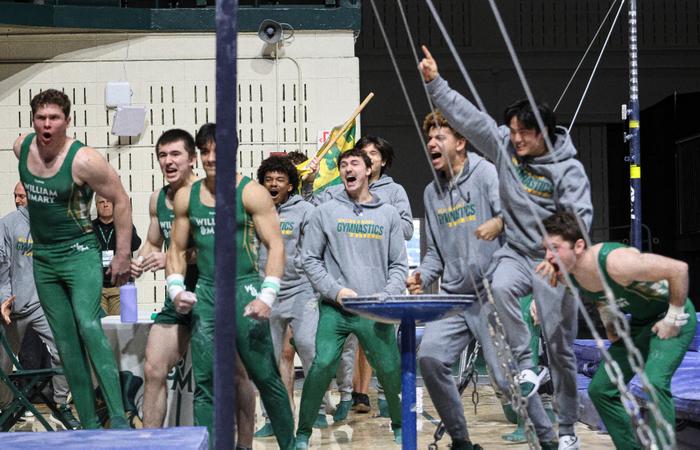
WILLIAMSBURG, Va. – The William & Mary men’s gymnastics team continued to build upon the program’s outstanding legacy of academic excellence with the selection of 17 gymnasts as College Gymnastics Association (CGA) Academic All-Americans.
Additionally, W&M placed sixth nationally in the team standings with a combined grade point average of 3.43.
W&M’s first-team honorees include: Alex Grapsas, Connor Barrow, David Moroney, Evan Sikra, Gavin Zborowski, Jonathan Irwin, Jared Noyman, Mark Fu, Michael Weiner, Niko Greenly, Will Harrington and Zachary Patrick.
Evan Wilkins, Luke Tully, Matthew Navarro, Ricky Pizem and Sam Lee garnered second-team distinction.
W&M’s success continues a long-standing tradition of excellence in the classroom by Tribe men’s gymnasts, as the program won the national academic team titles in 1991, 1992, 2002, 2008, 2012, 2014, 2015, 2016 and 2018, while placing second nine times (1994, 2000, 2001, 2003, 2009, 2013, 2019, 2020, 2022).
Additionally, W&M has finished third on five occasions (1999, 2006, 2011, 2017, 2024).
W&M’s nine academic titles rank second, just two behind Stanford.
College Gymnastics Association’s Top 10 Academic Teams
1. Stanford – 3.70
2. Illinois – 3.67
3. Springfield – 3.62
4. Simpson – 3.58
5. Penn State – 3.48
6. William & Mary – 3.43
7. Michigan – 3.34
8. Greenville – 3.39
9. Nebraska – 3.33
10. Oklahoma – 3.32
-

 Technology2 weeks ago
Technology2 weeks agoAlly Runs New Game Plan in WNBA All-Star Rookie Debut
-

 Health2 weeks ago
Health2 weeks agoThe Women Driving A New Era In U.S. Ski & Snowboard
-

 NIL2 weeks ago
NIL2 weeks agoESPN Announces 'dont wait run fast' by mgk as New College Football Anthem for 2025
-

 College Sports3 weeks ago
College Sports3 weeks agoCity rows to sporting destination goal on boats of new complexes & old strengths
-

 Sports3 weeks ago
Sports3 weeks agoNtekpere honored as Second Team Academic All-American | APG State News
-

 Health3 weeks ago
Health3 weeks agoTrump administration investigates Oregon's transgender athlete policies
-

 Rec Sports1 week ago
Rec Sports1 week agoSwimming & Diving Comments on the Rules – 2025-26
-

 Technology1 week ago
Technology1 week agoAmid Sports Chaos, ‘Known’ Data and Outcomes Help Agency Win
-

 College Sports2 weeks ago
College Sports2 weeks agoRep. Pugh: The Red Sand Project brings awareness to ‘very serious issue’
-

 Rec Sports1 week ago
Rec Sports1 week agoSternberg named new youth center director | News, Sports, Jobs


